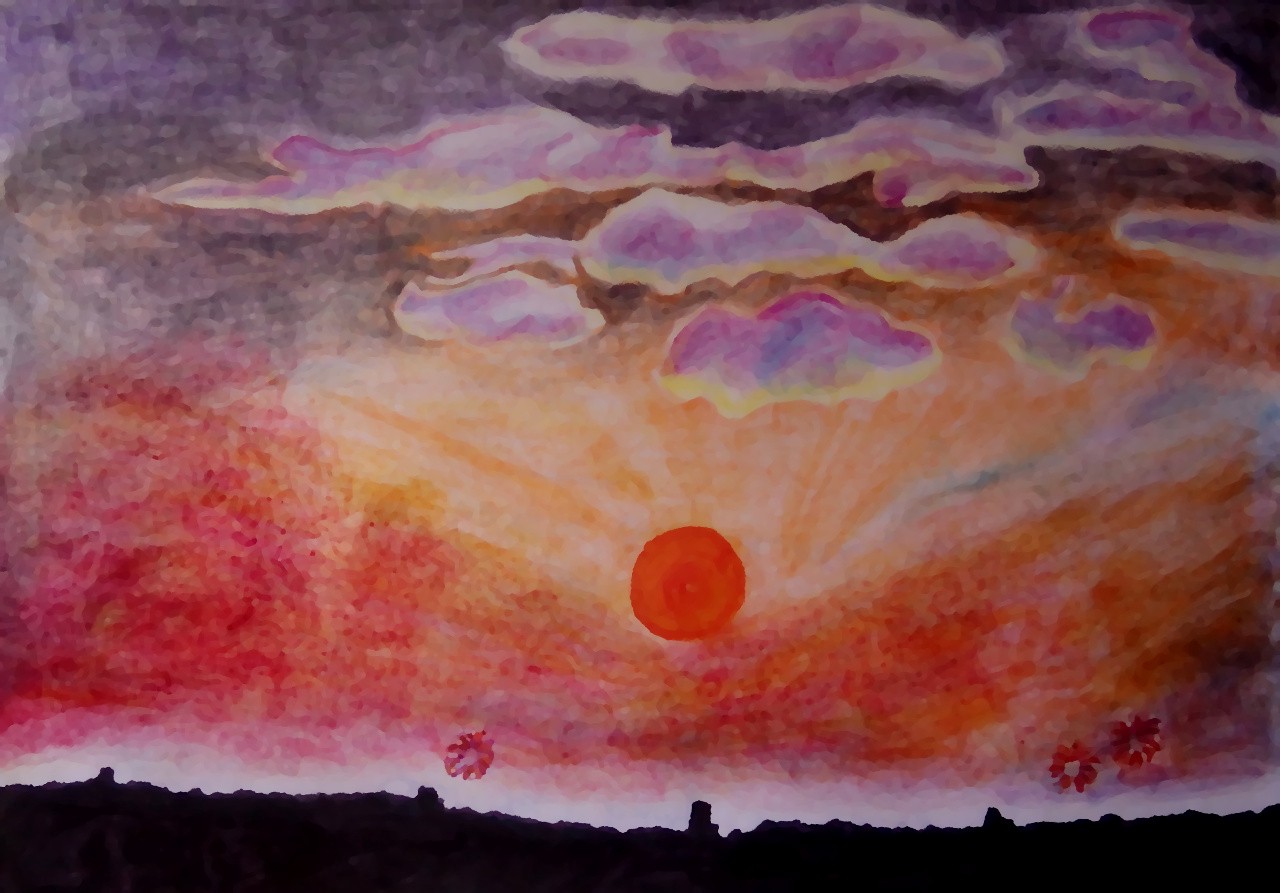Pretty, Polluted
How Diwali celebrations make for prettier sunsets.

How Diwali celebrations make for prettier sunsets.
The sky is a picturesque watercolour blend of grey and orange, the tangerine evening sun bleeding colour into the bleak grey dusk. There are other shades, too: a delicate lavender that stains the clouds, with dabs of lemon yellow in between, and a clear sky blue that lingers around the edges, not quite ready to make an exit.
It is six o’clock, on Thursday, the 8th of November, and the sunset today is more brilliant than most.
I could tell you that the sunsets are always beautiful here, in the countryside outside Bangalore. I could tell you that it’s something about the winter air that makes them more arresting than usual.
Of course, if I did, I’d be lying to you.
Why is the sky blue?
Try shining a flashlight through a glass of water with a little soap mixed in (if we were in a lab, you’d use sodium thiosulphate with a little sulphuric acid in it, but soap-water will do for now). What do you see?
Assuming you aren’t actually going to get up from wherever you’re sitting right now, I’m just going to tell you: It’ll look blue in the glass, but when it hits the wall on the other side, it’ll be closer to red.
The more soap there is, the redder it gets.
Remember that tidbit; we’ll come back to it.
White light scatters into seven distinct colours when it hits a particle. You probably learnt them in middle school: violet, indigo, blue, green, yellow, orange, and red. You might have learnt it using an acronym — VIBGYOR or ROY G. BIV — or to the tune of a snazzy rhyme, like I did.
How many colours are there in the rainbow?
How many colours are there in the rainbow?
Seven lovely colours are there in the rainbow
Seven lovely colours indeed
They are violet, indigo, blue, green, yellow
Violet, indigo, blue, green, yellow
Violet, indigo, blue, green, yellow
Orange aaand red!
The point is, they all scatter differently, and in different directions. Colours with shorter wavelengths, like violet and blue, scatter first and faster. Red, not obviously, is the last.
That’s why the water in the glass looks blue. The soap particles are scattering blue wavelengths your way, whereas the yellow and red ones keep going right past.
When you’re seeing the sky during the day, you’re really just seeing the atmosphere. And light is filtering through kilometres of it before it reaches you eye.
What is the atmosphere made of?
Particles—or molecules, really — of oxygen and nitrogen. Billions of them. Tiny ones, most of them smaller than ten microns. To put that into perspective, a human hair is about seventy-five microns across, give or take depending on how good your hair-care routine is.
Just like the soap, these molecules scatter blue, green, and violet light your way and the rest of it away.
Why don’t we see a purple sky? Because we’re more sensitive to blue than violet — which gets broken down into blue and red anyway. Red, green and blue make white, leaving some blue left over for you to see. That’s how your eyes work.
And that’s why the sky is blue.
But is it always blue? If you were sitting with me that evening in Bangalore, the answer would be obvious.
When you’re seeing the sun during the day, it’s light is travelling through kilometres of atmosphere to reach you. When it’s on the horizon, however, there are significantly more kilometres of atmosphere through which it has to go.
Remember what I said earlier, about the light being redder when there was more soap? The same principle applies here.
The light hits more particles, so more of it gets scattered away — leaving only the longer wavelengths, the redder tones, to make it to the other side. Whenever there’s any kind of small particle in the air, sunsets tend to get more red.
That’s why sunsets are so pretty over the ocean: there’s a lot of salt in the air to make them that way.
This year, the festival of Diwali falls on the 6th, 7th, or 8th of November. The date varies depending on which part of India you’re from, and which caste you belong to. There’s one thing that stays the same everywhere, however: firecrackers.
Crackers are a Diwali tradition, somehow appropriated and now as normal as new clothes or lighting dozens of earthen lamps around the house. Everyone bursts crackers, village or city, rich or poor.
Flower pots explode into showers of sparks ten feet tall, rising and falling like an elaborate crescendo. Suru-suru batthis draw lines of light in the air that tattoo themselves onto your eyelids, visible even after they’re gone. Bhoo-chakras spin delicately on the asphalt, drizzling gold that disappears instantly. Rockets whizz through the air, trailing fire like miniature comets.
Look up anywhere in the city, any time after sunset — and quite a bit of the time before sunrise, too — and you’re almost guaranteed to spot a sprinkle of glitter somewhere in the sky.
Diwalis are beautiful; they’re a visual feast.
And they’re causing more than a little bit of a problem.
The World Health Organisation uses a measure called PM10 to look at air pollution. PM10 consists of all particles in the air that are less than ten microns in diameter — the same size as the molecules that make up the atmosphere.
PM10 particles are what make up smog, and car exhaust, and that general sense of grey that maybe hangs over your city on some mornings. At that size, and in heavy concentration, little particles can cause a whole host of diseases, mostly respiratory. At it’s worst, walking through a polluted city can be like smoking several packs of cigarettes a day.
Which is why the World Health Organisation has a limit on PM10: sixty micrograms per cubic metre. To give you an idea of scale, a large drop of water is roughly 60 micrograms and a cubic meter is — well, a cubic metre is fairly self-explanatory.
Bangalore’s PM10 average is 83. And Delhi’s? Delhi’s is 292.
The city of New Delhi has been struggling with air pollution for years. Every winter, newspapers are splashed with freshly-scandalised headlines about its air quality.
The truth is, it’s massive ninteen-million-strong population aside, Delhi is also just geographically unlucky.
Not only is it at the centre of a basin that stretches across northern central India, trapping much of the pollution, it’s also surrounded by three states that burn their fields annually. In Punjab, Haryana, and Western Uttar Pradesh, farmers religiously burn their fields every year after the rice harvest.
That isn’t to absolve the city of responsibility — its colossal fossil-fuel emissions speak for themselves — but to say that it isn’t entirely self-contained. Cities like Chennai and Mumbai have the sea-wind to blow away their pollution, while Delhi has nothing.
Besides, whatever its crimes on a regular day, Delhi’s air turns lethal around Diwali, sometimes touching a solid 320 micrograms per cubic meter.
They say you shouldn’t play with fire because you might get burned. Crackers are what happened when we tried taming fire. But they’re still burning us.
Firecrackers are mostly made of sulphur and carbon, but there are usually a plethora of other chemicals in there, too, to serve various purposes: aluminium, copper, barium, antimony, and strontium, to name a few.
Different chemicals serve different purposes: antimony creates white flames and sparks while calcium deepens the colours; green-causing barium stabilises fellow elements and iron produces the sparks. And so on. The basic idea is, they help make fireworks look good.
And when you burst a cracker, these chemicals — not surprisingly — go up into the air. Most of these particles are smaller than ten microns. They fall instead under the category of PM2.5, particles smaller than 2.5 microns. That’s one-tenth of a third of the width of a human hair.
That’s small enough that you can inhale enough of it to do some serious damage.
That’s also small enough that a Diwali-level increase is significant enough to scatter yellow light away, and keep only the orange and the red for a time.
Bangalore’s doing slightly better than Delhi. Slightly.
Our Diwali PM10 readings hit 122, a forty-two percent increase from the norm. Still, “Diwali air pollution in Bengaluru dips 33%”, one newspaper declared jubilantly, stating a major decrease in pollution from last year’s celebrations.
And yet, the overall yearly average has only gone up by five micrograms since the year 2015–16, and it doesn’t show any signs of reducing.
But hey, why complain? Let’s sit back and enjoy the sunset.
Have something to say? At Snipette, we encourage questions, comments, corrections and clarifications — even if they are something that can be easily Googled! You can also sign up for our weekly email updates.
